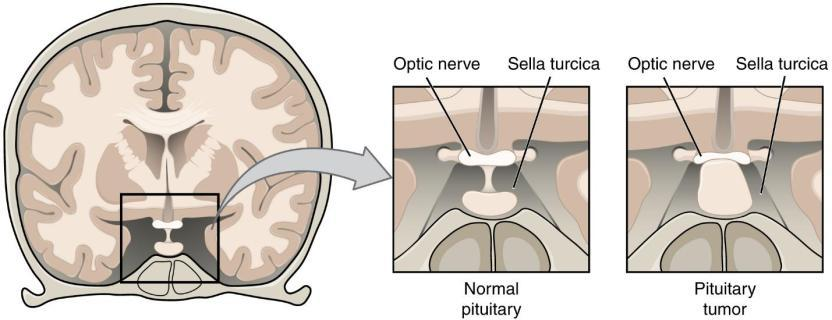
Sella turcica is found in which bone ?
A. Alisphenoid
B. Parietal
C. Frontal
D. Basi-sphenoid
Answer
492k+ views
Hint: Sella turcica is a depression, which is present within the skull of certain animals belonging to class Hominidae. It is present in animals such as human beings, orangutans, chimpanzees and gorillas. The word is of Latin origin meaning ‘Turkish seat’.
Complete answer:
The sella turcica which is a depression is found in a bond present in the lower part or floor of the human skull known as the basisphenoid. The depression belongs to the part known as the middle cranial fossa.

Considering the other given options:
Alesphenoid refers to a cartilage forming a wing-like shape. It functions as a socket for the human eye within the skull. Thus it is not the right option.
Parietal bone refers to a cranial bone present in the human skull, which forms the sides and the top portion of the human skull. The fuse together at the top to form the roof of the cranium. Thus it is not the right answer.
Frontal bone is also a part of the human skull. The bone forms a part of the bony portion present in the forehead and also extends as the bony orbital cavity that lodges the human eyes. Thus it is not the right option.
So, the correct answer is “Option D”. That is, Sella turcica is found in the basi-sphenoid bone.
Note:
The major function of the sella turcica is in acting as a seat for the pituitary gland also known as the hypophysis. The point of location of the gland sella turcica is known as the hypophyseal fossa. In some human beings, there is a chance of the pituitary gland getting flattened or shrunken, the condition is known as Empty sella syndrome.
Complete answer:
The sella turcica which is a depression is found in a bond present in the lower part or floor of the human skull known as the basisphenoid. The depression belongs to the part known as the middle cranial fossa.

Considering the other given options:
Alesphenoid refers to a cartilage forming a wing-like shape. It functions as a socket for the human eye within the skull. Thus it is not the right option.
Parietal bone refers to a cranial bone present in the human skull, which forms the sides and the top portion of the human skull. The fuse together at the top to form the roof of the cranium. Thus it is not the right answer.
Frontal bone is also a part of the human skull. The bone forms a part of the bony portion present in the forehead and also extends as the bony orbital cavity that lodges the human eyes. Thus it is not the right option.
So, the correct answer is “Option D”. That is, Sella turcica is found in the basi-sphenoid bone.
Note:
The major function of the sella turcica is in acting as a seat for the pituitary gland also known as the hypophysis. The point of location of the gland sella turcica is known as the hypophyseal fossa. In some human beings, there is a chance of the pituitary gland getting flattened or shrunken, the condition is known as Empty sella syndrome.
Recently Updated Pages
Why are manures considered better than fertilizers class 11 biology CBSE

Find the coordinates of the midpoint of the line segment class 11 maths CBSE

Distinguish between static friction limiting friction class 11 physics CBSE

The Chairman of the constituent Assembly was A Jawaharlal class 11 social science CBSE

The first National Commission on Labour NCL submitted class 11 social science CBSE

Number of all subshell of n + l 7 is A 4 B 5 C 6 D class 11 chemistry CBSE

Trending doubts
Differentiate between an exothermic and an endothermic class 11 chemistry CBSE

10 examples of friction in our daily life

One Metric ton is equal to kg A 10000 B 1000 C 100 class 11 physics CBSE

Difference Between Prokaryotic Cells and Eukaryotic Cells

1 Quintal is equal to a 110 kg b 10 kg c 100kg d 1000 class 11 physics CBSE

State the laws of reflection of light




